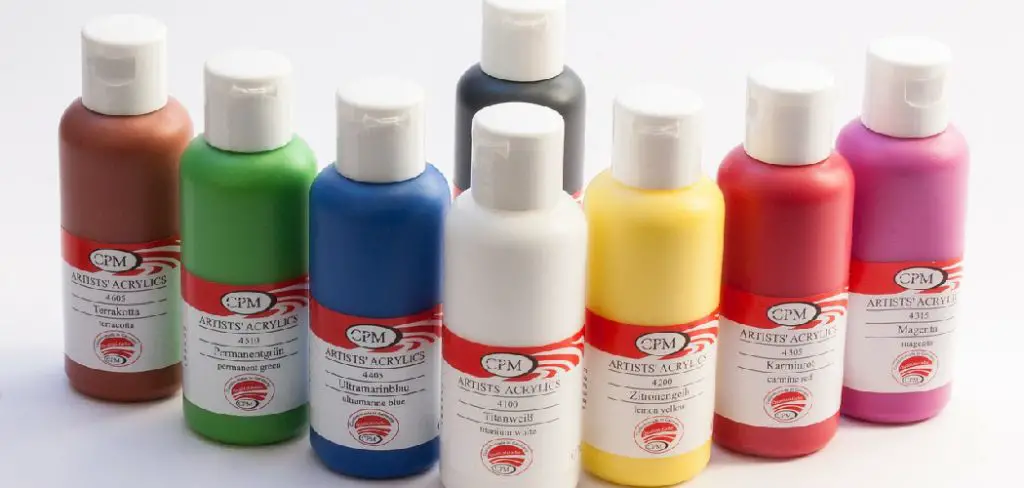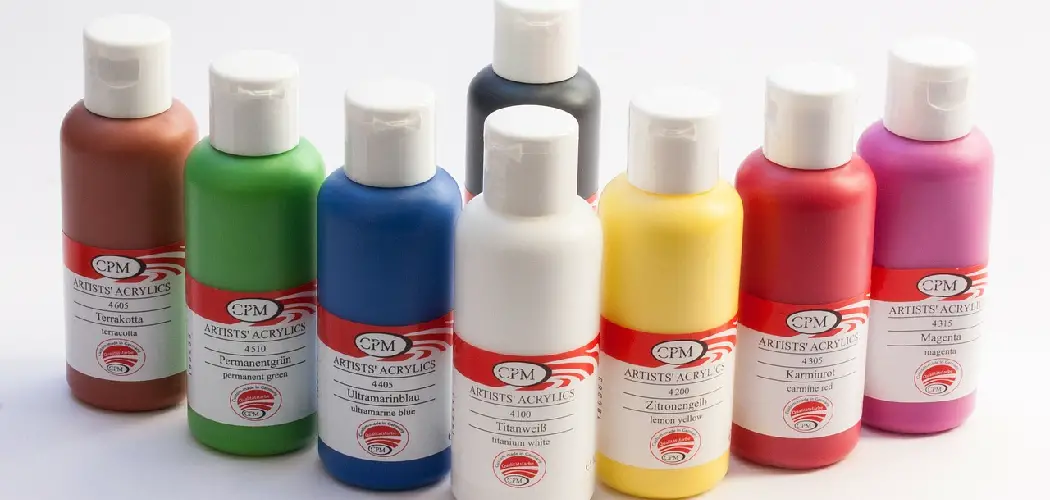To fix rubbery acrylic paint, simply mix in a small amount of water or acrylic medium. Rubbery paint is often caused by over-thinning or overworking the paint.
Acrylic paint is a popular medium for both beginners and advanced artists due to its versatility, quick-drying time, and vibrant colors. Despite these benefits, acrylic paint can sometimes become rubbery and difficult to work with. This may be due to an excessive amount of water or medium added to the paint, or from overworking it.
Whatever the cause may be, there are a few simple steps that you can take to fix rubbery acrylic paint. In this article, we will explore some of the common causes of rubbery acrylic paint, the steps to fix it, and some preventative measures to avoid it in the future.

Understanding Rubbery Acrylic Paint
What Is Rubbery Acrylic Paint?
Acrylic paint is an incredibly versatile and popular medium used by many artists. It dries quickly and creates a water-resistant and flexible surface that doesn’t crack easily. However, sometimes acrylic paint can become rubbery, which can cause a range of issues depending on what you’re using the paint for.
Rubbery acrylic paint is an issue where the paint doesn’t dry or cures adequately, causing the paint to have a rubber-like texture.
Here are a few key things to keep in mind when it comes to understanding rubbery acrylic paint:
- Acrylic polymer emulsion is a primary component of acrylic paint, and it’s what makes the paint more elastic and flexible.
- Acrylic paint can feel rubbery immediately after application, and that’s a normal part of the drying process. It usually takes about 24 hours to dry completely.
- If the paint is still rubbery after drying, it can mean that there was an issue with the paint’s formulation or application.
Why Does Acrylic Paint Turn Rubbery?
Acrylic paint can turn rubbery due to many reasons, from environmental conditions to issues with the paint itself. Here are some common causes of rubbery acrylic paint:
- Poor storage: If the paint is exposed to extreme temperatures or humidity, it can affect the paint’s formulation and cause it to become rubbery.
- Over-thinning the paint: Using too much water or medium to thin the acrylic paint can also lead to rubbery paint, as it can affect the paint’s film-forming properties.
- Poor application: Inadequate priming and preparation of the surface, applying the paint too thickly, or not allowing enough drying time in between coats can all cause rubbery paint.
- Poor quality paint: Sometimes, lower quality paints contain less of the critical ingredients that help acrylic paint dry and cure correctly, leading to rubbery paint.
If you’re dealing with rubbery acrylic paint, it’s essential to understand what’s caused the problem before trying to fix it. By identifying the cause, you can effectively remedy the situation and ensure that your acrylic paintings are beautiful and long-lasting.
Assessing The Damage
Identifying The Reasons Behind Rubbery Acrylic Paint
Acrylic paint is a popular art medium used by professionals and beginners alike. However, sometimes the paint can become rubbery and not dry completely. Here are some common reasons behind rubbery finish on acrylic paint:
- Low-quality paint that has gone bad or expired
- Adding too much water to the paint
- Painting in humid or cold conditions
- Inadequate ventilation
Before diving into the solutions to fix rubbery acrylic paint, it is essential to first assess the scope of the damage.
Understanding The Scope Of The Damage
Before taking any corrective measures, you should determine how severe the damage is. Here are some common ways to assess the scope of the damage:
- Touch the surface of the paint to determine if it feels sticky or tacky.
- Observe the surface of the painting for any peeling or flaking.
- Press a piece of plastic wrap onto the surface of the paint to determine if it sticks.
If any of these signs are present, then you need to take corrective action. In the next section, we will discuss the solutions to fix rubbery acrylic paint.
The Tools And Materials You Will Need
Rubbery acrylic paint can be frustrating to work with, but fortunately, it can be fixed with the right tools and materials. In this section, we will discuss the tools and materials you will need to fix rubbery acrylic paint.
Tools Required
To fix rubbery acrylic paint, you will need the following tools:
- Fine-grit sandpaper
- Clean cloth
- Paintbrush
- Acrylic medium
- Palette knife
- Heat gun or blow dryer
Before you start fixing your rubbery acrylic paint, make sure your workspace is clean and free from dust. You don’t want any debris mixing with your paint and creating a rough surface.
Materials Required
Apart from the tools mentioned above, you will also need to have the following materials:
- Acrylic paint(s)
- Water
When selecting paints, make sure you choose those that are of high quality. They should be well-pigmented and not be too old. Older paints are more prone to drying out and becoming rubbery. Additionally, you will also need to have access to water, as acrylic paint is water-based.
To summarize, you will need a set of tools to help you sand, clean, and apply new paint, as well as acrylic medium and a heat gun or blow dryer. In terms of materials, you will need high-quality acrylic paint and water.
With these in tow, you’re now ready to fix rubbery acrylic paint.
How To Fix Rubbery Acrylic Paint
Acrylic paints are a great medium loved by many artists because they dry quickly, allowing you to layer your paint and complete your art piece faster. However, sometimes, acrylic paint can get rubbery, and this can frustrate an artist and ruin their art piece.
Rubberiness may occur because you have not used the correct amount of water in your paint mixture or accidentally added too much water during the painting process. Luckily, there is a way to fix rubbery acrylic paint, and we are going to show you how.
Step-By-Step Instructions
Follow these simple steps to fix rubbery acrylic paint:
- Scrape off as much of the rubbery paint as possible using a spatula or palette knife.
- Next, sand the surface gently using fine-grit sandpaper. Sanding will remove the remaining rubbery layer.
- Wipe off the sanding dust using a clean and dry cloth.
- Then, use a primer to prime the surface area lightly. This step will seal the surface and ensure that the paint sticks.
- Allow the primer to dry completely.
- Finally, repaint your art piece using acrylic paint, and remember to use the right amount of water in your paint mixture.
Tips To Ensure Success
- Always use the right amount of water in your paint mixture. Adding too much water can make the paint mixture brittle and rubbery.
- Before painting, test the paint consistency on a scrap piece of paper. This way, you can ensure that the paint is not too watery and that it will bond correctly.
- Once you have applied the paint, allow it to dry completely before painting on top of it.
- When storing your acrylic paints, make sure to close the containers tightly. Proper storage will prevent the paint from drying out, becoming too thick, and eventually rubbery.
Fixing rubbery acrylic paint may seem like a challenging task, but it’s quite easy. By following these simple steps and tips, you can fix your rubbery acrylic paint, ensuring that you create a masterpiece that will last a long time.
Preventing Future Incidents
When it comes to painting with acrylics, one of the biggest frustrations is when the paint becomes rubbery or sticky. This can make it difficult to work with and can ruin your artwork. In the previous sections, we discussed how to fix rubbery acrylic paint, but what can you do to prevent it from happening?
How To Prevent Rubbery Acrylic Paint
Here are some best practices for acrylic painters to prevent their paint from becoming rubbery:
- Use a good quality acrylic paint: Using a good quality acrylic paint can make a huge difference in the outcome of your artwork. Cheap acrylic paints often have a higher water content which can cause the paint to become rubbery over time.
- Avoid over-thinning: Acrylic paints are water-based and can be thinned with water. However, over-thinning the paint can cause it to become rubbery. To avoid this, use a thinning medium designed for acrylic paints.
- Work in a well-ventilated area: Acrylic paints release fumes which can contribute to the rubbery texture. Working in a well-ventilated area can help to dissipate the fumes and prevent the paint from becoming rubbery.
- Store your paint properly: Proper storage of your acrylic paint can help to prevent it from becoming rubbery. Store your paint in a cool, dry place and avoid exposing it to extreme temperatures or direct sunlight.
- Mix in a retarder: Acrylic paint retarders can slow down the drying time of the paint and prevent it from becoming rubbery. Mix in a little bit of retarder to your paint to keep it workable for longer periods of time.
- Use thicker layers of paint: Thin layers of paint can dry too quickly and become rubbery. Using thicker layers can allow the paint to dry more slowly and prevent it from becoming rubbery.
- Clean your brushes properly: Acrylic paint can build up on your brushes and cause them to become stiff and bristly. Clean your brushes properly after each use to prevent this from happening.
- Don’t rush: Rushing your painting process can cause you to use too much water or overwork the paint, causing it to become rubbery. Take your time and let each layer dry completely before adding another layer.
- Use a varnish: A protective coating of varnish can help to prevent your acrylic paint from becoming rubbery, as well as protect it from uv light and other environmental factors.
- Always read the label: Every brand of paint is different, so make sure to read the label and follow the manufacturer’s recommendations for best results.
By following these best practices, you can prevent your acrylic paint from becoming rubbery and create beautiful, long-lasting artwork. Happy painting!
Frequently Asked Questions For How To Fix Rubbery Acrylic Paint
Why Is My Acrylic Paint Rubbery?
Acrylic paint becomes rubbery when it’s overworked, thickened, or old. Overworking the paint, not mixing it properly, and letting it dry on the brush are the common reasons behind rubbery acrylic paint.
Can You Fix Rubbery Acrylic Paint?
Yes, you can fix rubbery acrylic paint. Add water to the paint, mix it thoroughly and heat it for a few seconds in the microwave. You can also use a hairdryer to heat it. If the paint is still rubbery, mix it with a medium or flow improver.
What Can I Add To Acrylic Paint To Make It Flow Better?
You can add a medium or flow improver to acrylic paint to make it flow better. These additives reduce surface tension, allowing the paint to flow smoothly and evenly. You can also use water, but that may dilute the color and reduce the quality of the paint.
How Can I Prevent My Acrylic Paint From Getting Rubbery?
To prevent your acrylic paint from getting rubbery, don’t overwork it and mix it properly. Clean your brushes and palette immediately after use. Store your paint bottles upside down to prevent skin formation on the paint’s surface. Use airtight containers to store your paints.
Can I Still Use Rubbery Acrylic Paint?
It depends on how rubbery the paint is. If it’s slightly rubbery, you can add some water, a medium, or a flow improver to make it workable again. However, if the paint has become hard, cracked, or separated, it’s time to discard it.
Conclusion
To sum it up, rubbery acrylic paint can be frustrating but fortunately, it is not impossible to fix. With a little bit of patience, you can easily adjust the consistency of your paint and achieve the desired texture. Always start by adding a small amount of water or medium and remember to stir thoroughly.
If your paint has been contaminated by another medium, remove the top layer and use a fresh batch. And lastly, don’t forget to store your paints in their respective containers and cap them tightly after use to prevent them from drying out or becoming rubbery.
By following these simple tips, you’ll be able to revive any rubbery paint and create stunning artworks with ease. Happy painting!

